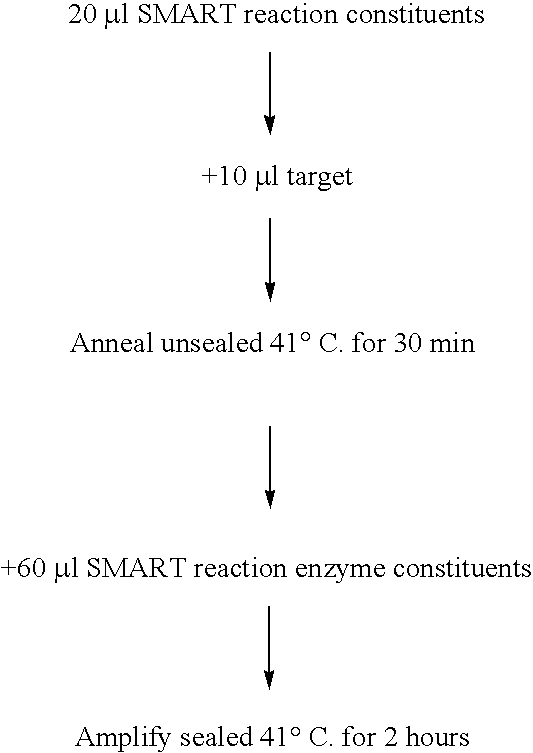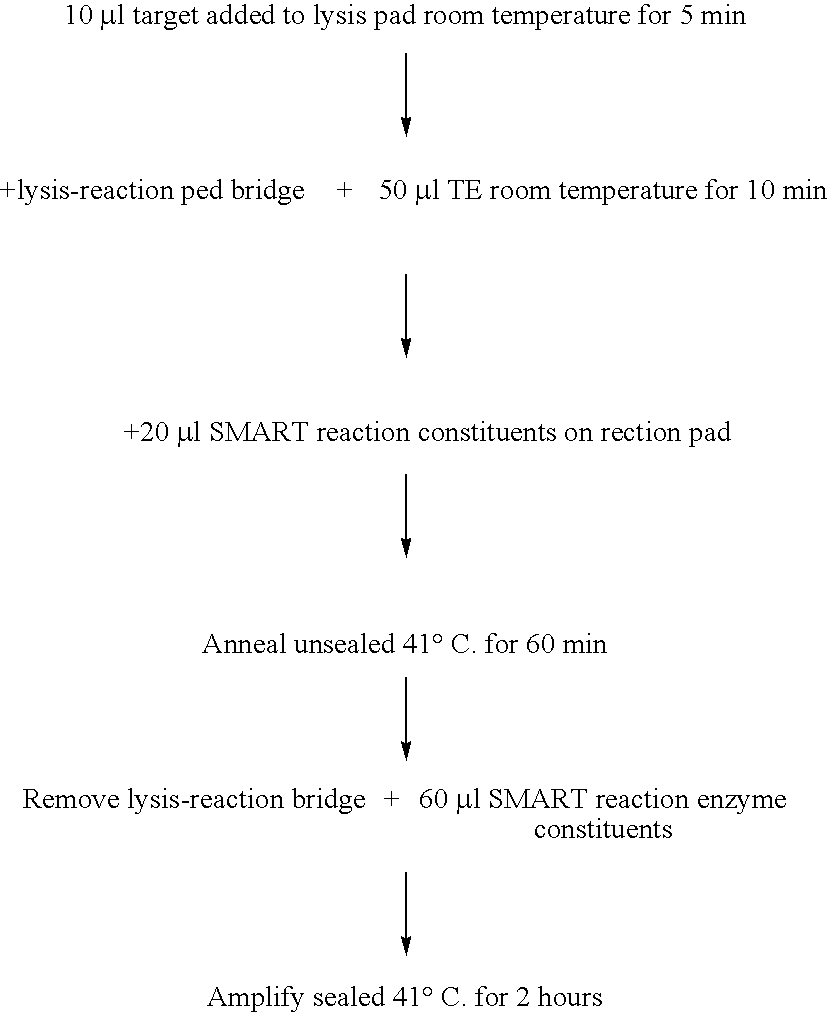Lateral flow assay device and method
a technology of lateral flow and assay device, which is applied in the field of lateral flow assay device, can solve the problems of high cost, limited application, and complex equipment, and achieve the effects of enhancing capillary flow, facilitating device handling, and high absorbency
- Summary
- Abstract
- Description
- Claims
- Application Information
AI Technical Summary
Benefits of technology
Problems solved by technology
Method used
Image
Examples
example 1
[0087] This example demonstrates that the method essentially outlined in WO 99 / 37806 (SMART) can take place on samples of solid matrices as would be used in a lateral flow device. E. coli 23S rRNA was used as target for this example.
Preparation of Oligonucleotides
[0088] All oligonucleotide probes were synthesised by phosphoramidite chemistry using an Applied Biosystems 380A synthesiser according to the manufacturer's instructions. Octanediol incorporation was accomplished by reaction of the growing chain with Octanediol-phosphoramidite (Oswel). Biotinylation of oligonucleotide probes was achieved by incorporation of a biotin phosphoramidite. Oligonucleotides functionalised with Alkaline Phosphatase were prepared using the manufacturer's proprietary method (Oswel). All oligonucleotides were HPLC purified using standard techniques.
Preparation of RNA
[0089] RNA for the positive reactions was prepared from the strain E. coli K12 with the Qiagen RNeasy total RNA preparation kit, usi...
example 2
[0098] This example demonstrates detection of target nucleic acid following lysis of bacterial cells and putative immobilization of the nucleic acid by Whatman FTA paper using the isothermal nucleic acid amplification method essentially described in WO 99 / 37806 (SMART). It also demonstrates that addition of SMART reagents to Whatman FTA paper (FTA® Classic Card), following said lysis and immobilization, results in a target-specific SMART reaction.
Preparation of Oligonucleotides
[0099] All oligonucleotide probes were synthesised and purified as described in Example 1. Additionally, oligonucleotides functionalised with Horse Radish Peroxidase were prepared using the manufacturer's proprietary method (Oswel).
Preparation of RNA
[0100] Cells for the positive reactions were prepared by incubation of E. coli K12 in Nutrient Broth (Oxoid) for 16 hours at 37° C. Cells for the negative reaction were prepared by incubation of Acinetobacter spp. in Nutrient Broth (Oxoid) for 16 hours at 37°...
example 3
[0118] This example demonstrates that a synthetic DNA homologue of the signal (RNA1) from a SMART reaction (WO 99 / 37806) could be detected on a lateral flow device (dipstick).
Preparation of Oligonucleotides
[0119] All oligonucleotides probes were synthesised and purified as described in Example 1. Additionally, oligonucleotides labelled with dinitrophenol (DNP) were prepared using the manufacturer's proprietary method (Oswel).
Detection of a Synthetic Target Using a Lateral Flow Device (Dipstick)
[0120] Nitrocellulose dipsticks (Schleicher & Schuell) of 20 mm length, 5 mm width and a pore size of 5-12 μm, were impregnated with a line (0.5 mm width) of anti-biotin antibody 10 mm from the base of the stick.
Hybridisation Step
[0121] In a 0.2 mL reaction tube was mixed 2 μl 5× transcription buffer (Promega, 200 mM Tris pH 7.9, 30 mM MgCl2, 10 mM Spermidine and 50 mM NaCl) and 1 μl of a 1 μM solution in water of the biotinylated capture probe 4 and the DNP labelled detection probe 6...
PUM
| Property | Measurement | Unit |
|---|---|---|
| temperature | aaaaa | aaaaa |
| temperature | aaaaa | aaaaa |
| diameter | aaaaa | aaaaa |
Abstract
Description
Claims
Application Information
 Login to View More
Login to View More - R&D
- Intellectual Property
- Life Sciences
- Materials
- Tech Scout
- Unparalleled Data Quality
- Higher Quality Content
- 60% Fewer Hallucinations
Browse by: Latest US Patents, China's latest patents, Technical Efficacy Thesaurus, Application Domain, Technology Topic, Popular Technical Reports.
© 2025 PatSnap. All rights reserved.Legal|Privacy policy|Modern Slavery Act Transparency Statement|Sitemap|About US| Contact US: help@patsnap.com



